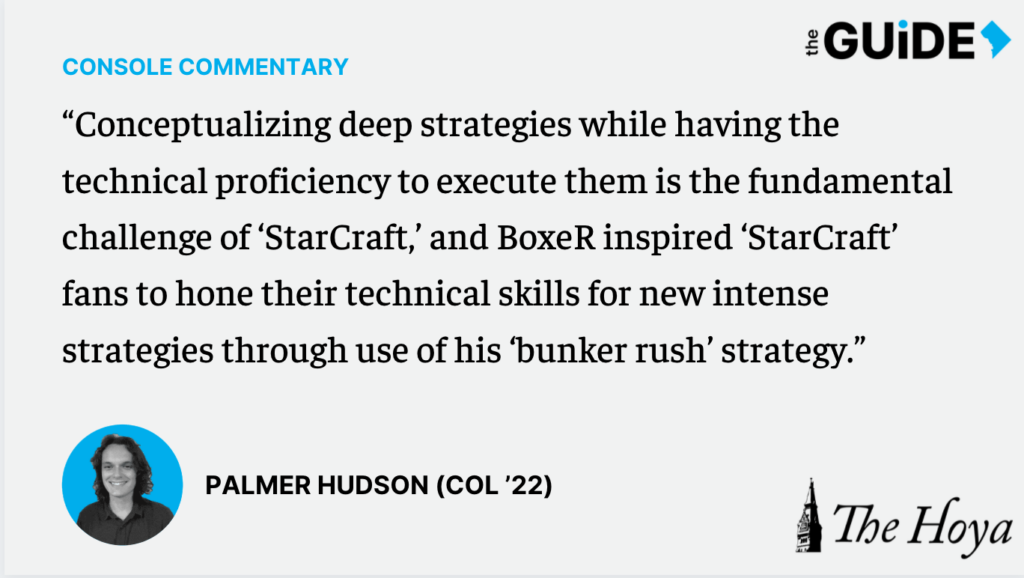When it comes to displays of skill in competitive video games, no genre has more exciting moments of genius strategic play than real-time strategy games.
Referred to colloquially as RTS games, these games are complex and challenging because they require calculated forethought and technical skill to realize tactical goals involved in overcoming opponents. “StarCraft” is a prime example of an RTS game that took the world, and especially South Korea, by storm after its release in 1998.
The premise of “StarCraft” is relatively simple: Each player chooses one of three tribes and builds one primary structure they call “home.” From this structure, the user commands workers to gather resources from the area while expanding their territory through additional construction. The player can then upgrade attributes of their workers and produce different kinds of fighting units like soldiers, tanks or even exploding aliens. The ultimate goal of “StarCraft” is to destroy your opponents’ structures while they attempt to bring the same fate to yours.
Early in the game’s history, the phrase “Zerg Rush” was popularized to refer to a strategy in which the Zerg tribe, a bizarre group of vomit-spewing aliens, would quickly allot all of their resources to produce cheap fighting units, overwhelming the opponent. The effectiveness of this strategy saw players try countless methods to defeat it across the competitive “StarCraft” scene.
Within this competitive side of “StarCraft,” many new strategies have emerged during intense tournament matches. Playing in the semifinals of the 2004 Ongamenet Starleague (OSL) “StarCraft” tournament in South Korea, one notable player named BoxeR (Lim Yo-hwan) came up against his long-time friend and rival, YellOw (Hong Jin-ho). BoxeR typically played using the Terran tribe, while YellOw was not only famous for playing Zerg but also for using the Zerg Rush strategy. Their matchup was one of the most anticipated of the tournament, and all eyes were prepared for a back and forth bloodbath between the players and their tribes.
BoxeR’s strategy during the semifinals of the 2004 OSL “StarCraft” tournament displayed his immense proficiency in the micro skill set of the game. Skill expression in “StarCraft” is split into two primary categories — general tactical skill known as macro play and precise technical play known as micro play. To take proper advantage of his new strategy, BoxeR had to perfect his micro play, performing hundreds of actions per minute in order to command his units perfectly.
While YellOw initially dominated with the Zerg Rush strategy, BoxeR endeavored to outrush the Zerg using his Terran tribe, a group of high-tech humans with marine gunmen and heavy machinery. One of the tribe’s structures is a bunker that can be filled with marines who can shoot out of the fortress but cannot be hit by enemies. However, if the bunker is destroyed, all the marines inside go with it.
BoxeR pioneered a strategy where he sent several workers at the very start of the game toward YellOw’s territory to start producing troops. BoxeR then slowly built a trail of bunkers near YellOw’s starting structure so that just as YellOw was starting to set up a rush of his own, BoxeR was already knocking on his doorstep.
BoxeR trained several marines as quickly as he could from the barracks he had built near YellOw’s base, sending them immediately into the Zerg bunkers. Commanding the marines to focus on individual enemies until the bunker was nearly destroyed, he quickly shuffled each marine out of one bunker and onto the next.
In just a few minutes, BoxeR had won the first match, before quickly proceeding to take the next two matches in similar fashion and taking the set in fewer than 30 minutes. Even though BoxeR went on to lose in the finals, his “bunker rush” strategy went on to become an infamous move still widely used in “StarCraft” today.
“StarCraft” is an incredibly difficult game to play because both macro play and micro play are so important. Conceptualizing deep strategies while having the technical proficiency to execute them is the fundamental challenge of “StarCraft,” and BoxeR inspired “StarCraft” fans to hone their technical skills for new intense strategies through use of his “bunker rush” strategy. By showing mastery of both macro and micro play, BoxeR quickly canonized himself in the “StarCraft” community.














